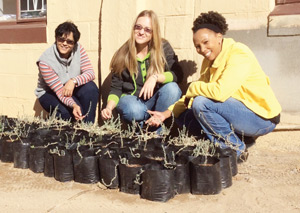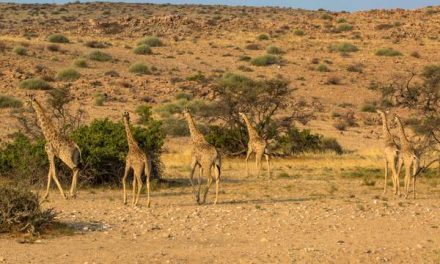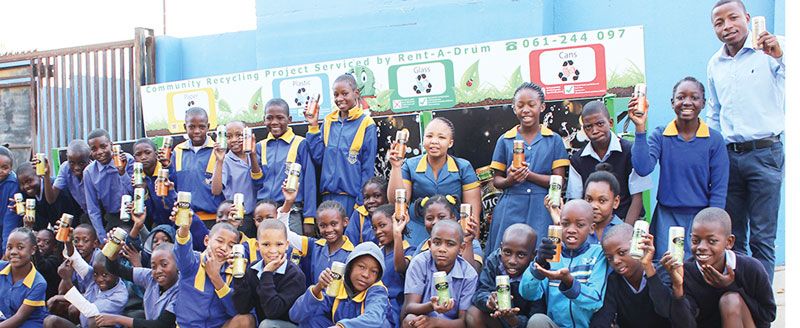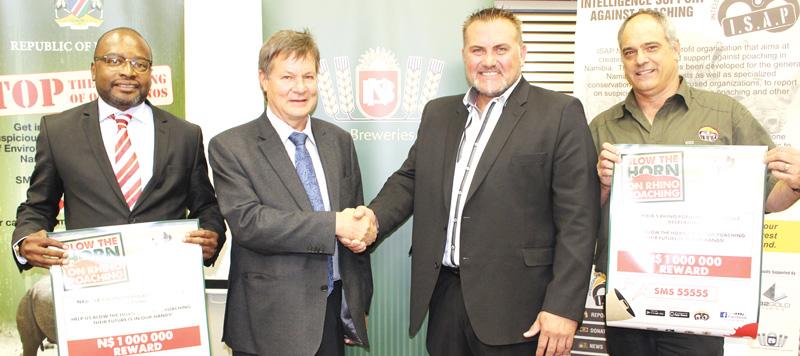
Restoring desert life when mining stops

The goal of the Coastal Restoration Research Programme is to understand the ecology behind the natural recovery of disturbed desert areas to design smarter restoration techniques. These techniques may range from the planting of keystone species to the manipulation of germination conditions. Here Ursula Witbooi (L) and Julien Cloete (R) of Namdeb’s Environmental Section, and Jessica Sack (centre) of Gobabeb’s NERMU look at some Salsola saplings that are prepared for relocation in the desert. For the following year, Jessica will be doing plant surveys (picture above) in a number of previously disturbed and rehabilitated areas along the coast from Chameis to Elizabeth Bay.
 After more than a hundred years of mining the coastal zone in the biologically diverse southern Namib, Namdeb Diamond Corporation has turned its attention to life after mining in the Tsau //Khaeb (Sperrgebiet) National Park.
After more than a hundred years of mining the coastal zone in the biologically diverse southern Namib, Namdeb Diamond Corporation has turned its attention to life after mining in the Tsau //Khaeb (Sperrgebiet) National Park. As part of its commitment to sustainability, Namdeb has approved a high-level rehabilitation plan for all its mining areas. This rehabilitation plan is slowly rolled out to guide both the restoration of worked-out areas and the environmental management of new mines within the park. With several mines along the coastal zone having been closed and with much of the infrastructure (except for historically important buildings) removed, the challenges shifts from mining to ecology.
In partnership with the Gobabeb Research and Training Centre’s NERMU (the Namib Ecological Restoration and Monitoring Unit), the Coastal Restoration Research Programme has commenced with a study on the natural recovery of vegetation communities in disturbed areas. The objective of this study is to understand the patterns and processes involved in re-colonising disturbed areas by the many species typical of the Succulent Karoo. This comprehensive study of vegetation succession builds on earlier results that suggested some of the very old worked-out areas have been naturally re-colonised with a range of native plants.
It is widely accepted that recovery of natural properties such as ecological structure, function and composition should not take long. Restoration activities should support the natural process of recovery, speeding it up, but simultaneously ensuring that it culminates in an acceptable ecological character. By providing insight into the factors that are associated with the return of these plants under natural conditions, the team hopes to be able to advise Namdeb how to design smarter restoration techniques and practices.
The project’s focus includes undisturbed areas and sites of different ages and as such the results will also provide Namdeb’s rehabilitation team with an ecological target and insight into how fast the rehabilitated areas should be recovering. The NERMU researchers said they are excited to be part of this project, which will not only allow two Namibian students to earn postgraduate degrees in environmental management, but will also improve the chances that mined areas can be returned to their natural states.
Jessica Sack of Gobabeb is currently doing a plant survey in a old exploration trenches near the Bogenfels ghost town. These trenches, which was made after 1976 (based on evidence from old aerial photos) have been re-colonised by a number of plant species, but some of the typical species of the surrounding area are still absent while others, which are rare in the undisturbed areas, are dominant in the trenches. The work done under the Namdeb Coastal Restoration Research Programme will contribute to an understanding why there are still some species missing even after so many years, and allow directed intervention to fully restore the natural ecology.










































